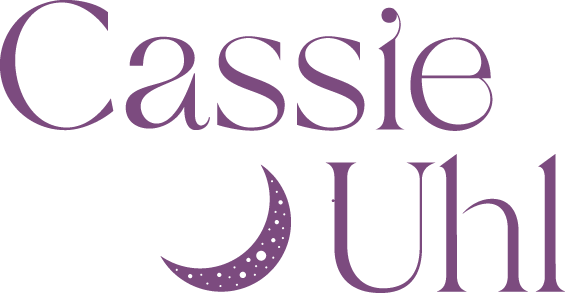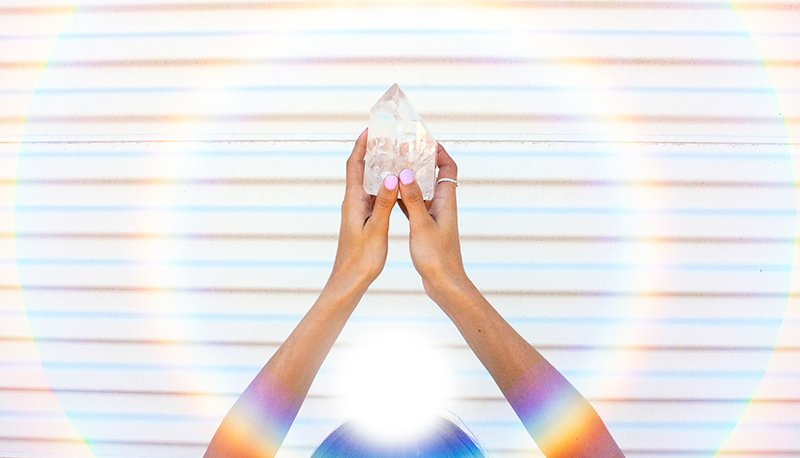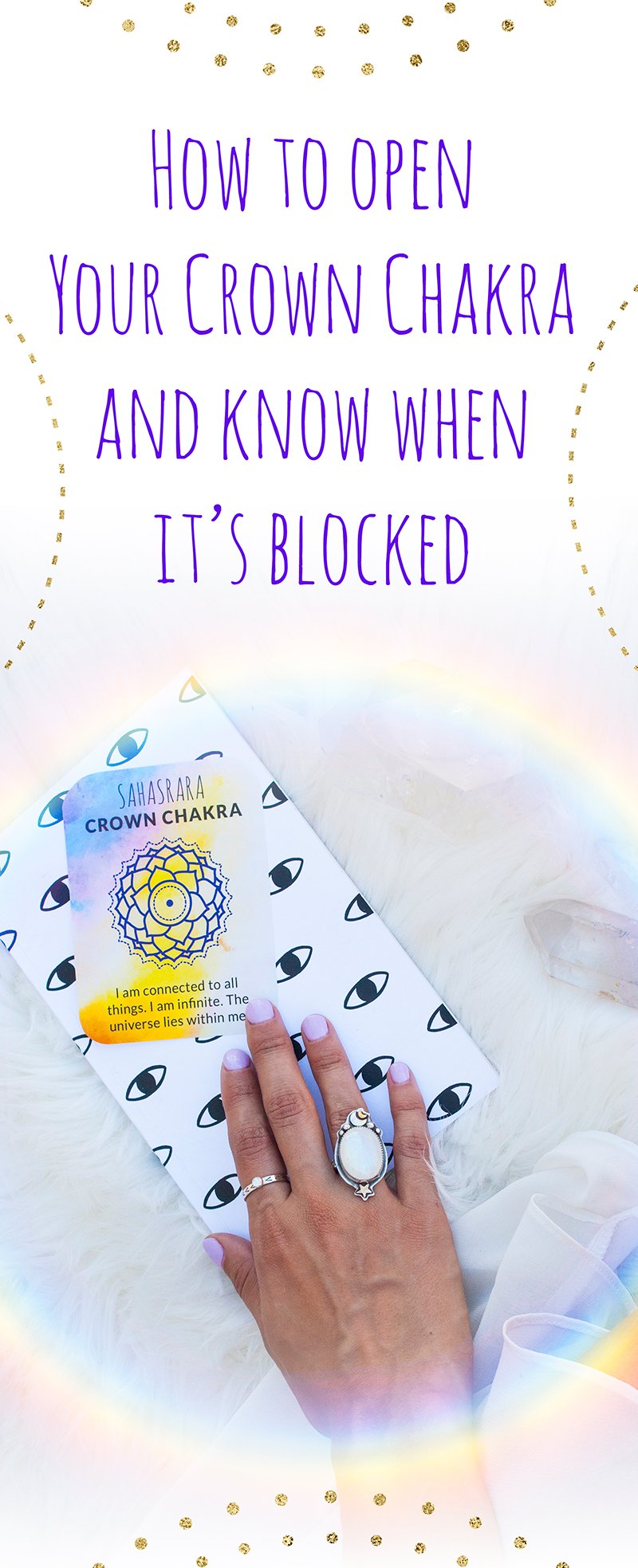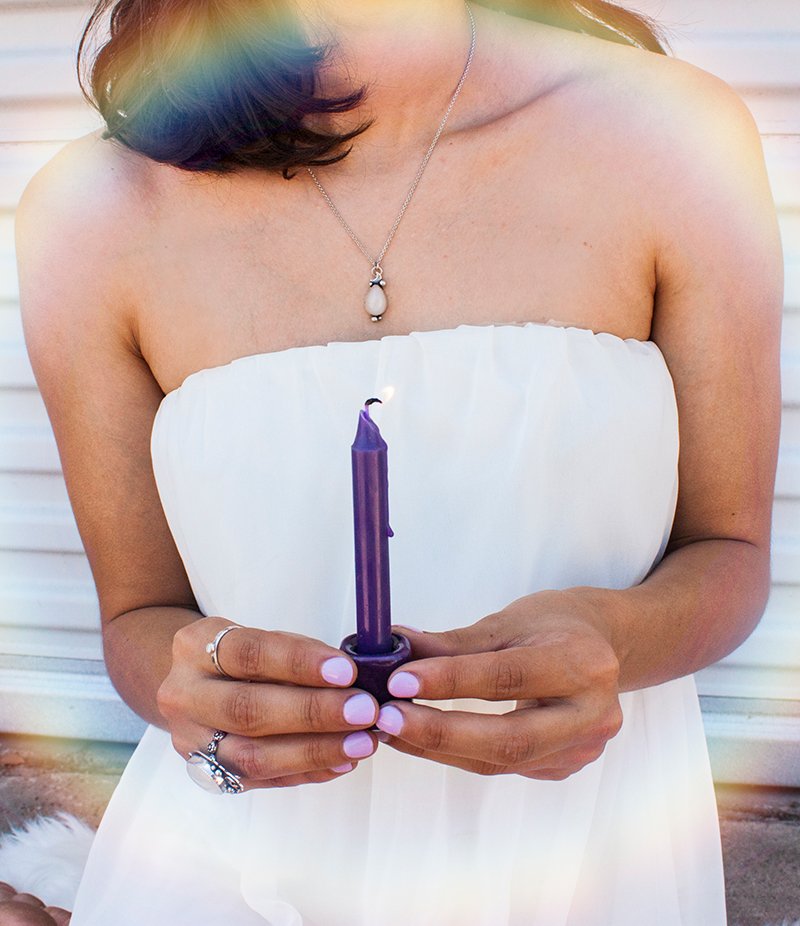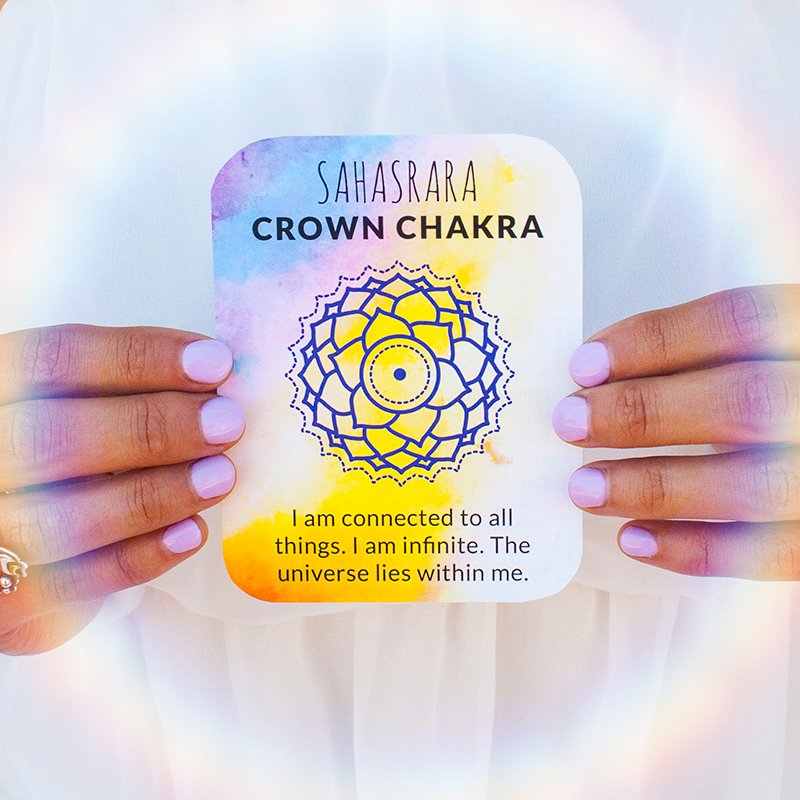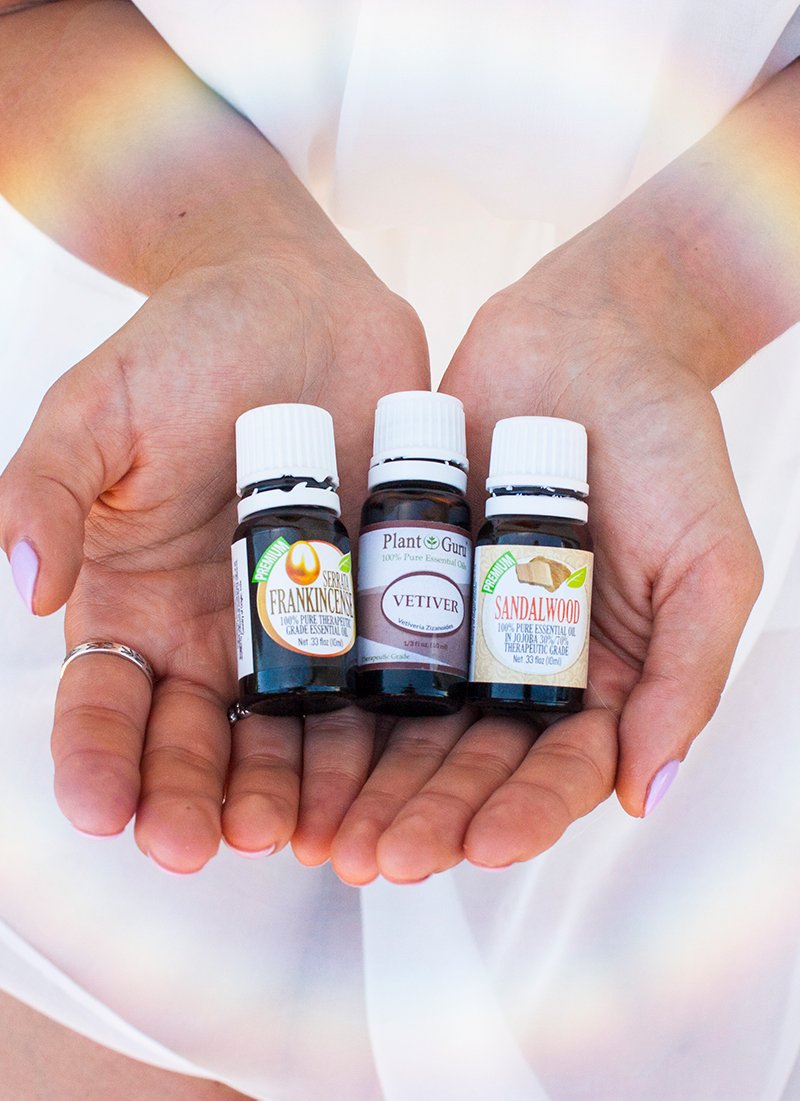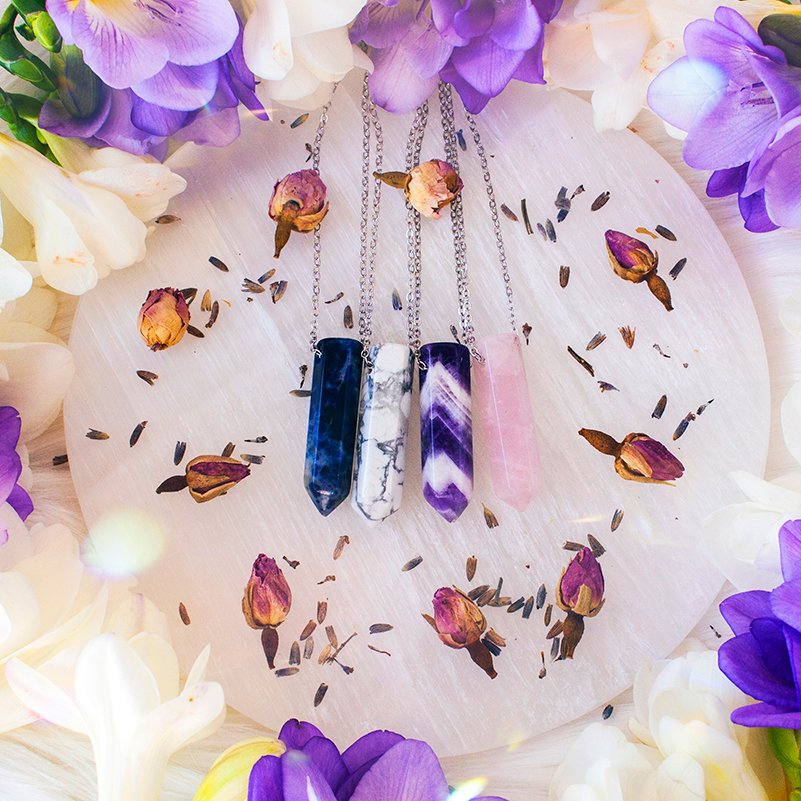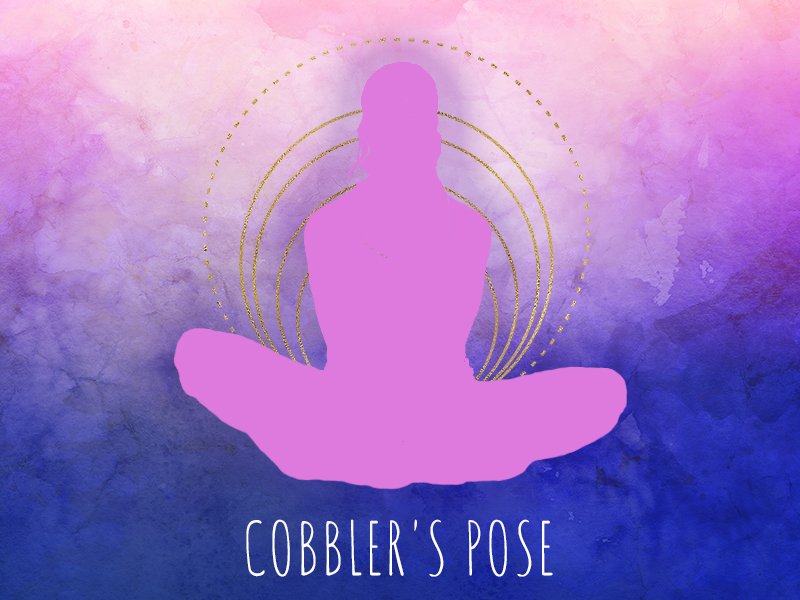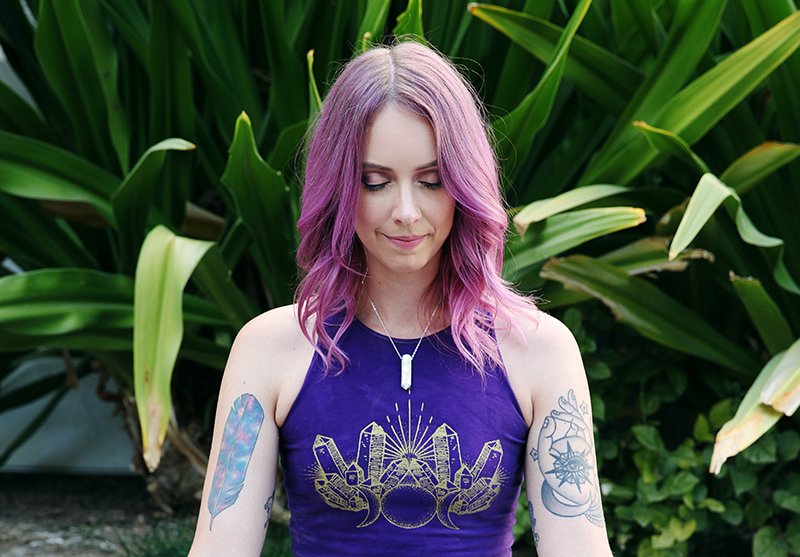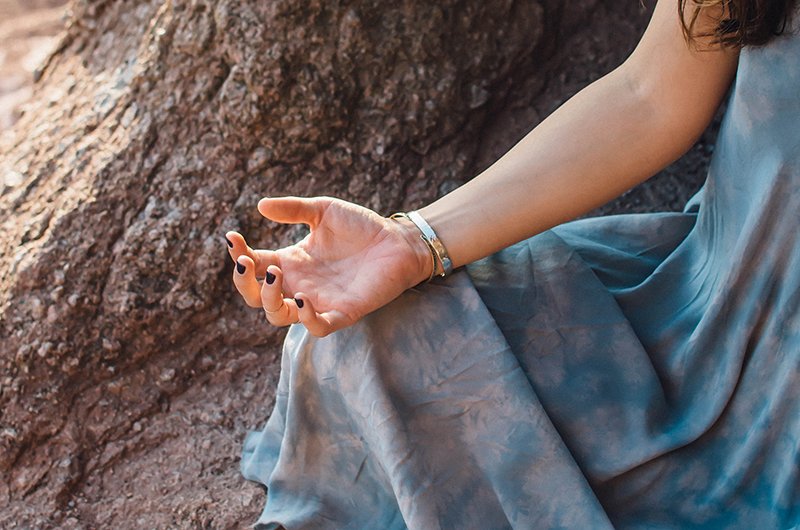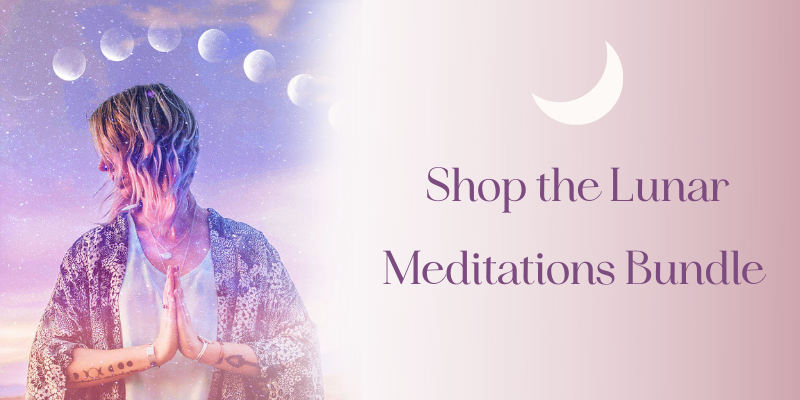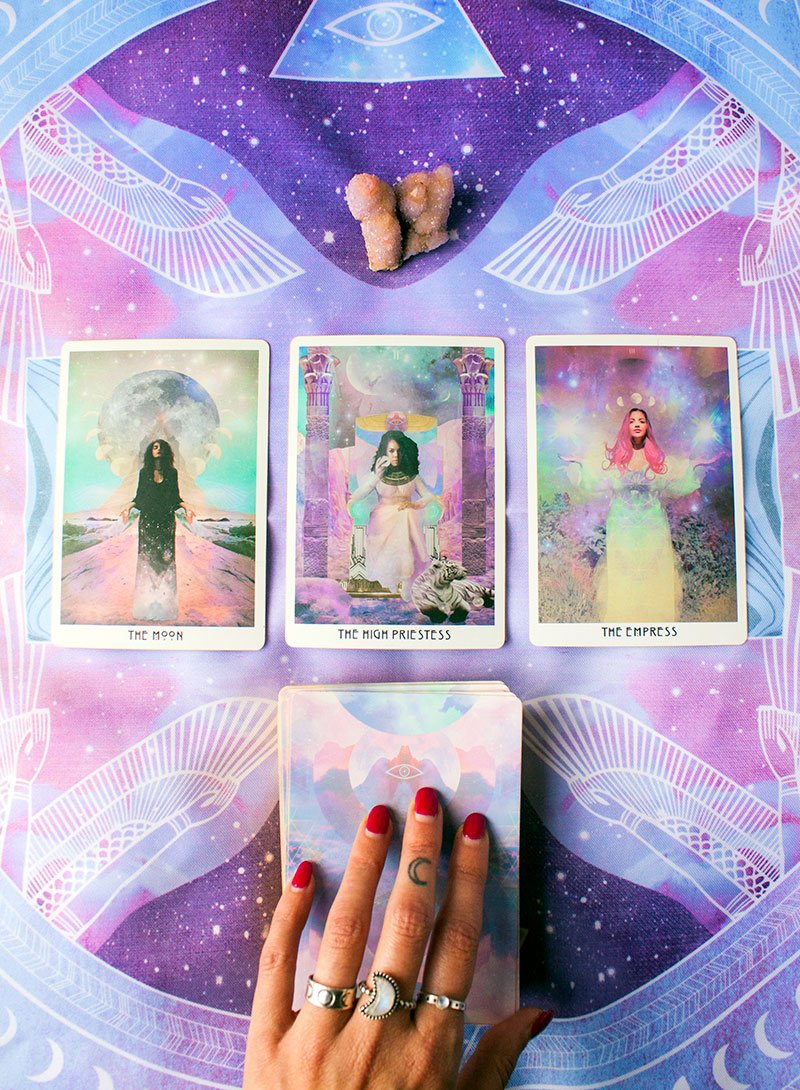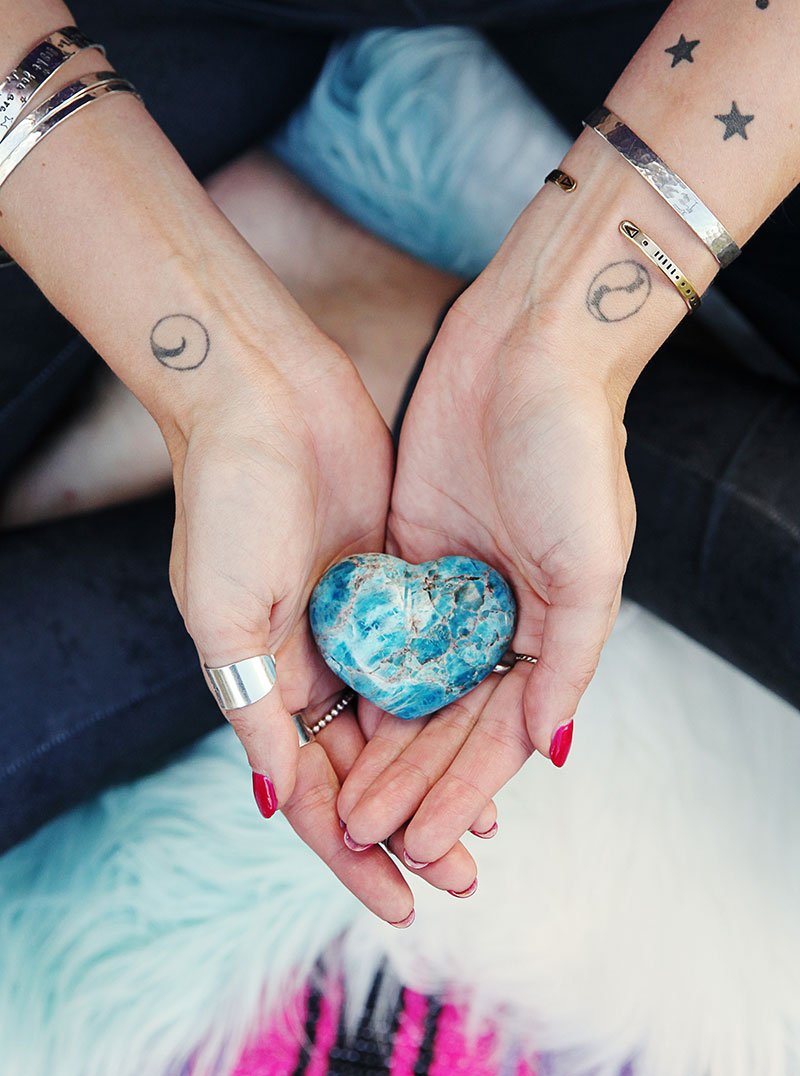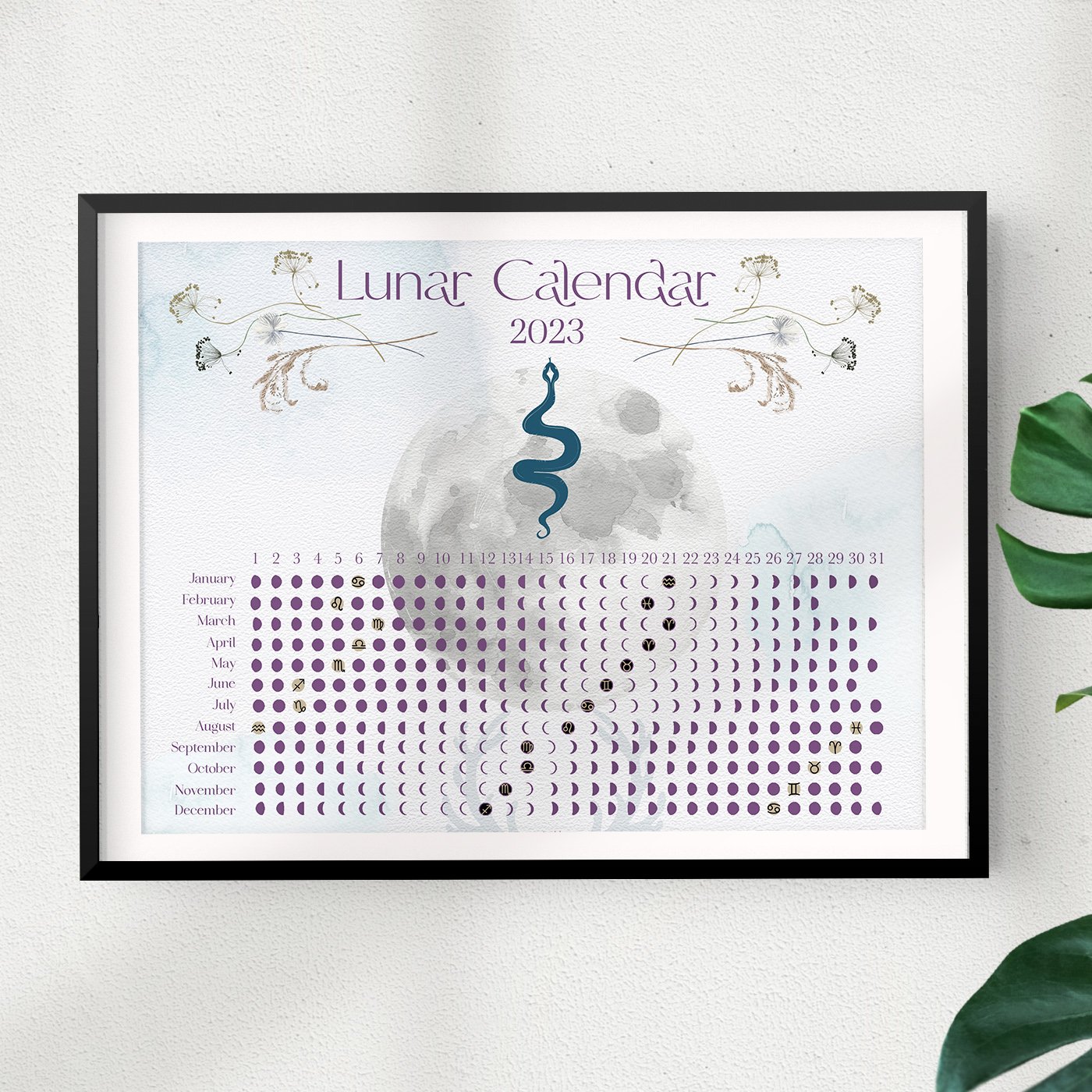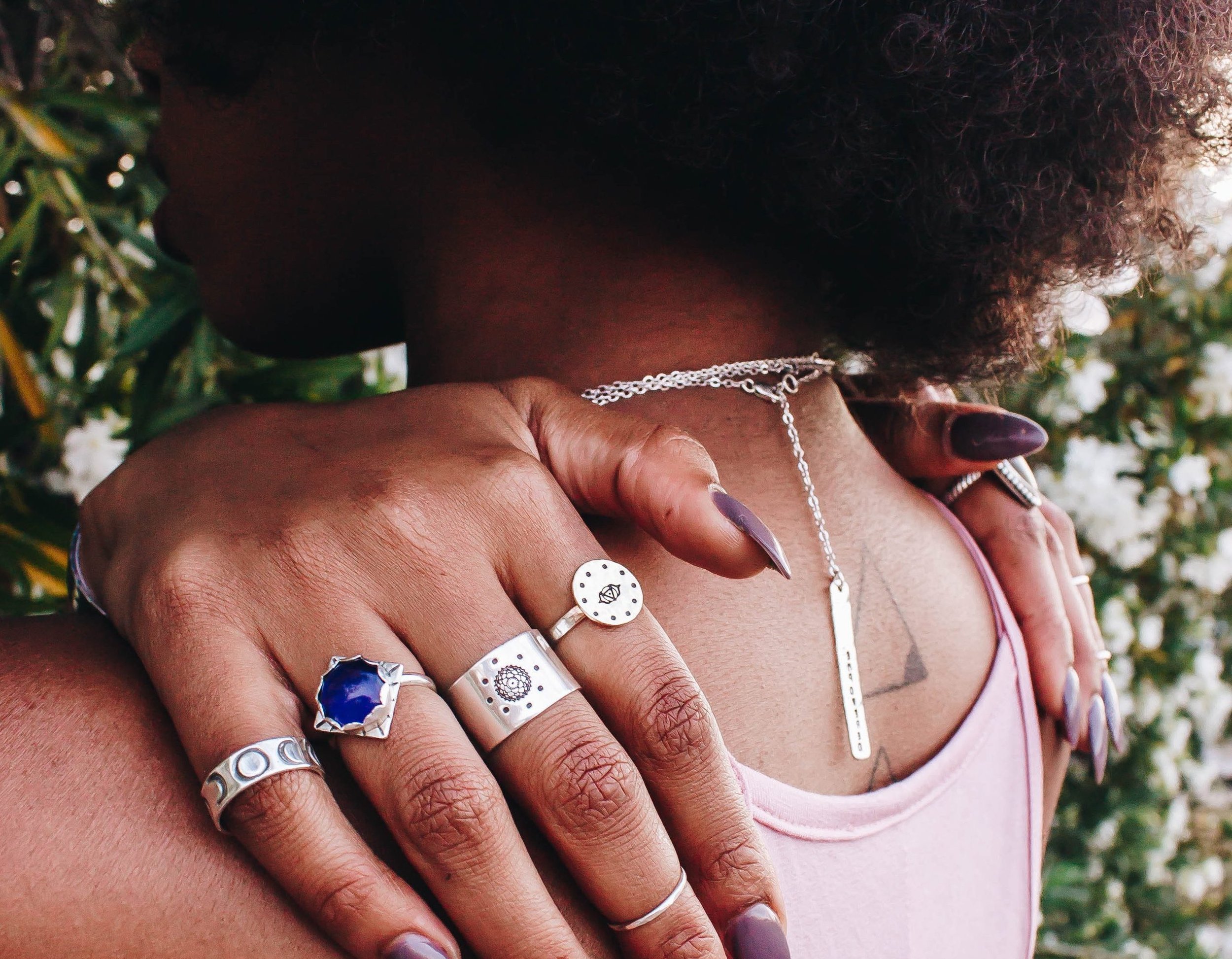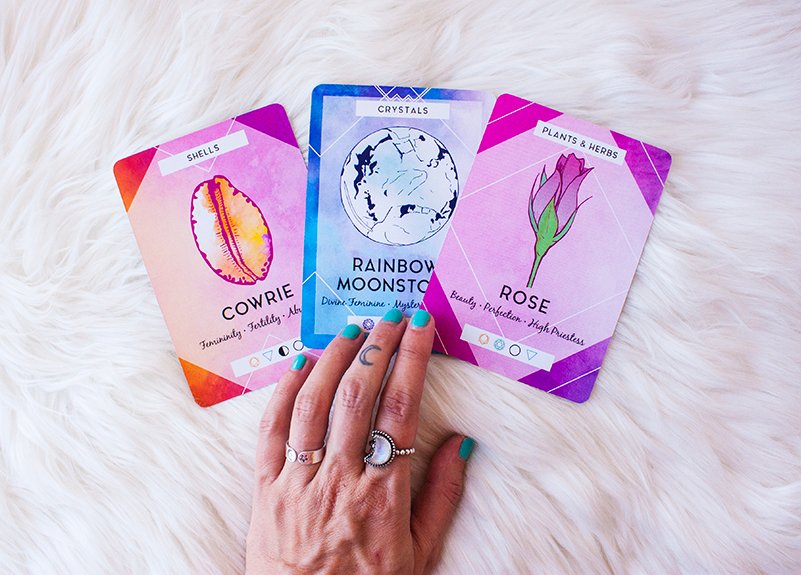How to Open Your Crown Chakra & Know When it’s Blocked
Your crown chakra, known as Sahasrara in Sanskrit, is the highest of the seven chakras in the traditional chakra system. It’s located on the crown of your head and is the center of your connection with the Universe and with your highest self.It’s where you’re able to channel messages from the divine, access higher states of consciousness, and deeply trust the Universe. An open crown chakra helps you connect with something greater than yourself, experience the interconnectedness of all beings, and know that you are truly taken care of by an abundant, loving Universe.
Your crown chakra, known as Sahasrara in Sanskrit, is the highest of the seven chakras in the traditional chakra system. It’s located on the crown of your head and is the center of your connection with the Universe and with your highest self.It’s where you’re able to channel messages from the divine, access higher states of consciousness, and deeply trust the Universe. An open crown chakra helps you connect with something greater than yourself, experience the interconnectedness of all beings, and know that you are truly taken care of by an abundant, loving Universe.When your crown chakra is blocked, it may manifest as:
Feeling disconnected from the Universe
Feeling disconnected from magic
Experiencing loneliness
Feeling like life is meaningless
Disconnection from your spiritual side
Experiencing migraines and headaches
Strong attachment to material possessions and achievements
If any of those sounds like you, don’t worry. Our chakras are ever fluid, just like us, and they can change from day to day. Scroll down to get eight ways to unblock your crown chakra and experience a connection with the divine.
Slow down
Are you stuck in the “grind?” Waking up, going to work, taking care of all the necessary human things in life but not tending to your inner world?The first thing you can do to open your crown chakra is to simply give it space to breathe by carving out more time in your day to just be. To read a good book, take a salt bath, or take a leisurely walk with the purpose of just experiencing the pleasure of the outdoors rather than getting somewhere.
Do a ritual
Maybe it’s been a while since you sat at your sacred space and made time for magick. That’s okay! Open your crown chakra by doing a ritual that is meaningful to you, or try this simple one.You’ll need:
Purple candle
Pen
Piece of paper
On your paper, write “I connect with the Universe” or a similar phrase. Create a sigil out of the phrase by removing all of the repeating letters and vowels, and connecting the lines together into a symbol.
Breathe that intention into your sigil. Take a moment to visualize how you will feel when your crown chakra is open and energy is flowing freely.
Then, light your candle, and burn your sigil over it as you continue to focus on your intention. You might like to say, “As I burn this paper, I connect with the Universe.”
You can rewrite your sigil on another page and place it on your altar as an ongoing prayer to the Universe.
Affirmations
The crown chakra is not associated with a bija (seed) mantra like the rest of your chakras. Try meditating on one of the affirmations below instead.
I am deeply connected with the Universe
I trust the flow of the Universe
I am a channel for divine wisdom
I am a channel for divine light
I am always open to receiving messages from the Universe
I am magic
I am light
I am a deeply spiritual being
Use scents
Try using one or more of the oils below on your skin, in your bath, or in a diffuser to open Sahasrara:
Frankincense for tranquility and meditation
Vetiver to connect with the divine and your own spiritual nature
Sandalwood to quiet your mind and ego
Helichrysum to help you access higher spiritual states
Palo Santo for healing, purification, and opening up to higher spiritual realms (be sure it comes from a sustainable and ethical source)
Learn more about balancing your chakras with aromatherapy and crystals from this past blog post.
Meditate
Find a comfortable seat and lengthen your spine from your tailbone to your crown. Start to breathe deeply, focusing on sending your breath to a white flower at the crown of your head.
As you continue to breathe, visualize this flower blossoming open, opening the crown of your head as a channel to the Universe, letting the bright white light of the divine enter your energy field.
When you feel complete, close with a deep breath in and a long breath out of your mouth.
You can also try one of our guided meditations here.
Crystals
Try working with rutilated quartz, clear quartz, sugilite, selenite, or amethyst to help you open your crown chakra. Meditate with them, place them on your altar or by your pillow while you sleep, and journal with them to see what comes up around what’s blocking your crown chakra.
Yoga poses
As we move up the spine to the higher chakras, they become more affected by meditation than by physical postures. But there are still some yoga poses you can use to open Sahasrara:
Headstand
This pose directly activates your crown chakra. It restores the flow of energy in your body and inverts the flow of blood towards your crown. If you have trouble balancing in headstand, try doing this pose against the wall— you’ll still get the benefits!
Savasana
The most important yoga pose. As you come into savasana, set your intention to open your crown chakra. Then remind yourself that it is safe to relax completely, and release into your savasana.
Half or full lotus pose
Lotus pose helps balance the body and mind, helping you tap into higher consciousness. Find a comfortable seat, and start in half lotus. If you’d like to go deeper, try the full version.
Pray
Send a simple prayer into the Universe: “Please help me connect with you. I am open and willing to receive messages.” Try saying this prayer or a similar prayer that resonates with you each morning when you wake up.
Yoga for the Dark Moon
I love the dark moon.The dark moon is all about resting (think four of swords in the tarot), taking care of yourself, and shedding anything that still needs to be released this cycle.The name of the game at the dark moon is soft, slow, and gentle. There’s no need to push yourself. What would make you feel good at this time? What would nurture your body, mind, and soul?A yin yoga practice is so lovely at this time of the month. The practice below focuses on gentle opening and a little twisting to help you sink into your body and breath. You’ll want to hold each of the poses for 3-5 minutes and let yourself really relax into them.
I love the dark moon.
The dark moon is all about resting (think four of swords in the tarot), taking care of yourself, and shedding anything that still needs to be released this cycle.
The name of the game at the dark moon is soft, slow, and gentle. There’s no need to push yourself. What would make you feel good at this time? What would nurture your body, mind, and soul?
A yin yoga practice is so lovely at this time of the month. The practice below focuses on gentle opening and a little twisting to help you sink into your body and breath. You’ll want to hold each of the poses for 3-5 minutes and let yourself really relax into them.
Grab your own moon phase ritual cards including the dark moon card featured above by clicking here.
I invite you to use a mantra or affirmation that speaks to you during this practice: a simple and beautiful one is Soham, or “I am.” This affirmation brings you right into the present moment and allows you to be still with what is.
Get into something comfy, and grab your blocks, a blanket, a pillow, essential oils, and whatever else would make this practice really nourishing for you. Turn on your favorite yoga playlist, light some candles, and roll out your mat.
Cobbler’s pose
Sit up on a block or blanket, and bring the soles of your feet together. Bring your hands to your feet, and give yourself a little foot massage. Rub your feet, your ankles, your calves, and if you feel like getting wild you can make your way up to your neck and shoulders, too! If you’re using essential oils, you can incorporate them here. A simple warming sesame oil would also work.
Shoulder opener
Laying on your belly, stretch your left arm out to your side and roll onto your left cheek. Bring your right palm under your right shoulder and roll onto your left hip. You can stay here, or you might like to go a little deeper by bending your right leg and planting your right foot behind you, and wrapping your right arm around your back.
Stay here with your breath for 3-5 minutes. Then come back to center and repeat on your right side.
Half frog
On your belly, stretch your arms out to a T and roll onto your left cheek. Open your right knee out to your side, stretching it out even with your hip if you can. If your knee is sensitive, slide your blanket under it. Allow yourself to be supported in this pose, and remind yourself that it is safe to relax completely.
After 3-5 minutes, shift back to center and over to the other side.
Cat cow
As you breathe through each movement of flexing and rounding your spine, visualize your breath flowing up and down your spine all the way from your tailbone to the crown of your head. Make this dynamic pose your own by taking circles or figure eights with your hips, stretching through your side body, coming onto your fingertips to get deeper into your back, or coming back for a child’s pose. What is your body craving here? Let your breath take you there.
Child’s pose
Try bringing your big toes together and knees wide, and roll a blanket or place a pillow between your legs. Release your chest and forehead onto your makeshift bolster. If you need to, feel free to turn your head to one side. Just make sure you turn it to the other side after a few minutes!
Heart Bench
Set up your blocks at two different heights at the top of your mat: the low and medium setting, or the medium and high setting. The second block should be vertical (long like your mat) and the first block at the very top of your mat should be horizontal.
Lower your back onto your blocks, first setting the second block up to run along your spine and end under your shoulder blades. The first block will come to the base of your skull, supporting your head and neck.
Bring the soles of your feet together and knees wide, and both palms to your belly. Breathe deeply into your belly, noticing how it feels to really expand in this area where we so often try to shrink and contract.
Let your awareness melt away after a few moments, and completely relax into this pose.
Supine Twist
Hug your knees to your chest and guide both knees over to one side, stretching out your opposite arm and turning your head in that direction. If there is a gap between your knees, it could feel good to slide a block between them. After 3-5 minutes, switch to the other side.
In this twist, bring your awareness to anything you’d still like to shed or release this cycle. With each exhale, visualize it leaving your body, mind, and soul.
Savasana
Even if you’re tempted, don’t skip savasana! This is the most important part of any yoga practice, especially with the dark moon. Get cozy here with any combination of pillows and blankets that feels good to you. You might like to put a pillow under your head, a rolled blanket under your knees, or even take a grounding crone savasana on your belly with each shoulder resting on a block. Stay here for 5 minutes or longer, allowing yourself to really rest. If you have plenty of time, find a yoga Nidra meditation to play.
After you finish your practice, you might like to take out your journal and write about anything that came up for you here.
Breaking Down the Yamas & Niyamas
In classical yoga philosophy, we use something called the Patanjali’s eight-fold path for guidance. These eight limbs, or steps, help us reach the state of ecstasy and deep connection with the divine known as samadhi.
If you’re reading this, you probably already know that there is a lot more to yoga than just asana, or physical postures.
In classical yoga philosophy, we use something called the Patanjali’s eight-fold path for guidance. These eight limbs, or steps, help us reach the state of ecstasy and deep connection with the divine known as samadhi.
Patanjali’s eight-fold path for guidance are:
Yamas
Niyamas
Asana
Pratyahara
Dharana
Dhyana
Samadhi
In this blog, I’ll be breaking down the first two limbs: the yamas and the niyamas.
Yamas
The first limb, the yamas, are about personal practices that relate to our interactions with others and to the outer world. They are:
Ahimsa, nonviolence
Satya, truthfulness
Asteya, non-stealing
Brahmacharya, moderation
Aparigraha, non-attachment
Ahimsa
This is probably the most well-known of the yamas (you probably know a yoga studio, clothing line, or juice bar named after this one, even if you didn’t know what it meant until now), with good reason.
Ahimsa isn’t just about a lack of violence, it’s about active compassion. To connect with this principle, ask yourself how you can bring more compassion into your relationship with yourself and each interaction with others.
Satya
Satya, truthfulness, speaks to not just honesty but to speaking your personal truth. To me, this principle is super connected to the throat chakra.
What does it feel like when your throat chakra is balanced? When you aren’t afraid to speak your truth, even when it’s uncomfortable? This is satya.
Asteya
Asteya, non-stealing, is about not taking what isn’t ours. This practice isn’t just about stealing physical items. Most of us wouldn’t steal a bracelet or a snack from a store. But what about stealing someone’s ideas? What about when you get extra change at the store or when a teacher you love accidentally registers you for an online course you never paid for? What then?
Coming back to this principle of non-stealing is a guiding light.
Brahmacharya
Brahmacharya is all about moderation, or as I like to think of it, balance. It’s an invitation to develop a self-care practice and most importantly, to remember to feed all parts of yourself.
It’s a reminder to come back to your center. To make space in your life for dancing and meditating, for green juice and French fries, for deep conscious connection and memes—or whatever else looks like balance for you.
Aparigraha
It’s really hard to practice aparigraha. The idea of non-attachment is that it’s none of your business how your work is received. Whatever it is that you put into the world, do it for the joy of creating, for the joy of connecting, for the joy of doing the thing, not for some end result.
We can do this in all areas of our lives: our interactions with our friends, families, and partners, our careers, our passion projects, everything.
Can you experience pleasure and be present in each moment, rather than being attached to what may happen in the future?
Aparigraha also refers to not being possessive or hoarding. It’s an invitation to allow yourself, your possessions, and your relationships to be in a constant state of flow.
Niyamas
The second limb, the niyamas, are about personal practices that relate to our inner world. They are:
Saucha, purity
Santosha, contentment
Tapas, self-discipline
Svadhyaya, self-study and inner exploration
Ishvara Pranidhana, surrender to God/Goddess
Saucha
Saucha can refer to the purity of the body, but more importantly, it’s about the purity of mind. This is an invitation to explore your thought patterns and limiting beliefs: What’s holding you back here? What thoughts take up the real estate of your mind, and are they serving you? Do judgment, fear, and lack consume your thoughts?
Saucha asks you to look at what’s really going on in your mind, and heal your thoughts.
Santosha
Santosha is about you—what you have and how you feel about it. It’s an invitation to be happy and content with everything that you have (which is a huge feat in a world that is always encouraging you to be unsatisfied and strive for more).
Think of santosha as embodying more lunar, yin energy: the energy of presence, of being, of contentment.
Tapas
Tapas is self-discipline. What is it that you want in life and are you willing to do what it takes to get there? It’s about showing up for yourself and really doing the work: sending those emails, grinding out that report, finishing your work instead of going to that happy hour.
It’s also about doing the work on yourself, by staying on your healing journey and doing the more physical work like eating healthy, practicing yoga every day, and meditating every day.
When you think of tapas, think of the Chariot in the tarot. This is about pushing forward in service of your greater vision.
Svadhyaya
Svadhyaya is key to your spiritual practice.
Who are you, really? What do you value? What are your deepest desires? What are your greatest fears? What brings you joy and purpose?
This niyama is all about learning about yourself and exploring your inner ocean.
Practices like meditating, journaling, shadow work, astrology, past life regression, and divination can all be part of svadhyaya.
Ishvara Pranidhana
Surrender to the energy of a higher power, whatever that means to you: whether it’s Source, Goddess, the Universe, God, or something else.
Practicing all of the other niyamas will help you get into a state where you are able to surrender to the Universe. Where you trust the constant flow of the Universe and know that it is an abundant and loving place where more magic than you could ever imagine is unfolding all the time.
Purify your mind. Practice gratitude. Do what you can with tapas. Explore your inner oceans. And then, it’s time to lay it all at the feet of the Universe and let magic take over.
Yoga for the 4 Elements
Fire, water, earth, and air are the four elements of the Universe. They make up all that is, everything we see around us, and everything we are.None of them are either good or bad, and they each have specific, different properties.Fire, associated with your solar plexus chakra, is connected with passion and inspiration. Water, associated with your sacral chakra, is all about emotion and intuition. Air, associated with your heart and throat chakras, is about communication. Earth, associated with your root chakra, is connected with grounding and stability.There are many different ways to connect with and balance the four elements in your body and life: eating certain foods, meditation, visualization, spending time with the elements in nature, such as the ocean, connecting with crystals associated with each element, and more.But one of my favorite ways to connect with the elements is through using yoga.
Fire, water, earth, and air are the four elements of the Universe. They make up all that is, everything we see around us, and everything we are.
None of them are either good or bad, and they each have specific, different properties.
Fire, associated with your solar plexus chakra, is connected with passion and inspiration. Water, associated with your sacral chakra, is all about emotion and intuition. Air, associated with your heart and throat chakras, is about communication. Earth, associated with your root chakra, is connected with grounding and stability.
There are many different ways to connect with and balance the four elements in your body and life: eating certain foods, meditation, visualization, spending time with the elements in nature, such as the ocean, connecting with crystals associated with each element, and more.
But one of my favorite ways to connect with the elements is through using yoga.
There are two ways to use yoga for the elements:
1. To create more of an element you desire.
For example, if you want to feel more grounded you’ll want to connect with the Earth. If you want to stimulate your creativity or get out of your comfort zone, you’ll want to connect with fire.
2. To balance an element you feel you have too much of.
For example, if you’re feeling overly emotional, you may want to balance the water element by working with its opposite, fire. If you’re feeling materialistic or too stuck in your ways you’ll want to balance the Earth element by working with its opposite, air.
Scroll down to get ideas for different styles of yoga, poses, and some breathwork to connect with each of the four elements of the universe.
Yoga for Fire
To connect with the element of fire, you’ll want to do a power or vinyasa-style yoga flow focused on stimulating your core, where your solar plexus resides.
Suraya Namaskar. For a fire practice, you’ll want to start off with a series of sun salutations. There are several different variations, but I recommend this one:
Mountain pose at the top of your mat
Arms lifted over head
Hand to foot pose
High lunge on your left side
Plank pose
Chaturanga
Upward-facing dog
Downward-facing dog
High lunge on your right side
Hand to foot pose
Arms lifted over head
Mountain pose
That’s one sequence. Do as many as you’d like! And remember that you can always modify your high lunge by lowering your back knee for a less intense version.
Plank pose. Nothing lights a fire in your belly like a plank pose. Try keeping a slight micro bend in your elbow and lifting from the back of your heart space so you really get into your belly.
Boat pose. There are two variations you can take: knees bent (gentler) or legs straight. Try starting with your knees bent and then straighten your legs after a few breaths if you feel strong and steady.
Chair pose. In this pose, tuck your tailbone and really focus on your core. Bring your awareness to those muscles, and see how the posture changes for you. If you feel like adding a little detoxifying in, take a twisted chair variation.
Agni Sara pranayama. You’ll look weird, but you’ll literally feel yourself getting hot. Start in a standing position with your knees gently bent and your hands on your knees. As you inhale, fill your belly with breath. As you exhale, draw in your lower and upper core muscles, hollowing out your stomach.
Yoga for Water
A hip-opening slow-flow style yoga practice will connect you with the element of water. As you move through each pose, imagine that you are moving through water. What would that feel like? What would that look like?
Low crescent lunge. Keep your back knee lowered to keep this pose a little more gentle, and work on finding a little more balance in your hips. If you’re lunging on the left side, try pulling your left hip back and right hip forward to get you there.
Incorporating a mudra into this pose can be really nice, too. Try flowing through Padma, or Lotus, mudra by bringing your hands to lotus mudra at the heart center, inhaling to lift your hands overhead, and exhaling to cascade your arms down and back to your heart center.
Lizard pose. Time to really get into the hips. Be gentle with your body here and use props like blocks or a bolster as needed! Ask yourself: what do I need to feel good in this pose? And listen to your body’s wisdom.
Child’s pose into cobra flow. Start in child’s pose with your legs parallel instead of knees wide. As you inhale, shift all the way forward onto your belly and into cobra pose. Your exhale brings you back to the child’s pose. Keep flowing with your breath, trying to move as slowly and mindfully as possible.
Wide-legged forward fold. Start standing with your legs wide and hangs to your hips. Inhale to open your chest, and exhale to fold, releasing your palms to your mat, ankles, or to a yogi toe hold. After a few breaths here, you might like to add in a side body stretch by walking both hands to the left side of your mat, and then to the right side.
Reclining cobbler’s pose. Bring one palm to the heart and one palm to the belly, and visualize your breath flowing up and down your spine like water with each inhale and exhale. Connect with your heart space and notice any places that your breath feels shallow or stuck. See if you can make your breath deep, smooth, and fluid.
Yoga for Earth
A grounding yin yoga practice will connect you with the Earth. As you settle in each pose, notice the Earth below you. Notice how it grounds you, supports you, and nurtures you. Spend at least five minutes in each of these poses, connecting with your breath.
Malasana seated on a block. As you sit in a yogi squat with your palms at the heart center, visualize your breath running all the way down your spine and out your tailbone, grounding you and rooting you to the Earth a little bit deeper with each inhale.
Caterpillar pose. Place a block on your thighs at whatever height you need to allow your body to completely relax and round forward over your legs. Instead of trying to stretch your hands to meet your feet, let them fall to your sides wherever they naturally do.
Half frog variation on belly. This is one of my favorite poses. Lying on your belly, turn onto your right cheek and stretch your arms out to a T. Bend your left knee and open your hip out to your left side. Take five minutes on this side, and then switch to your right side.
Thread the needle. Try to completely relax through the hips, spine, and shoulders here as you rest on your shoulder and head. For the gentlest variation, walk your other arm out in front of you and release it completely to your mat. You also have the option to wrap that arm around the lower back for a gentle bind. Just find what feels good for you, and return to your breath.
Seated straddle. Sit up on a block for extra support as you take your legs wide. First turn your torso to your left leg and round your spine over that leg, bringing your forehead to a block or to your knee. Then turn to your right leg, and then walk your palms out in front of you and round in the center.
Yoga for Air
A heart-opening, throat-opening Hatha flow style yoga practice will connect you with the element of Air. As you move through these poses, visualize green light beaming out of your heart chakra, opening you up to a flow of unconditional love, and blue light beaming out of your throat chakra, opening you up to speak your truth freely.
Camel pose. Camel pose opens up both of these chakras beautifully when you allow your neck to drop back. Focus on pressing your pelvis forward and opening the front side of your body rather than bending your back body. Breathe into your heart space, and see that green wheel of energy softening, opening, and expanding.
Bow pose. Bow pose opens both your throat and your heart chakras as well. Notice how your breath sinks you lower onto your mat with each inhale and takes you deeper into the pose with each exhale.
Upward-facing dog. Open your throat chakra with the upward-facing dog. You can try it as part of a flow from plank to chaturanga to upward-facing dog to downward-facing dog to really connect with the element of air.
Heart bench. Set up your blocks on whatever setting feels best for you, and make the block supporting your head lower than the block running along your spine for extra throat chakra opening.
Plow pose. Skip this one if you have any back or neck problems. But if not, it’s a beautiful opener for your throat, heart, and solar plexus (bonus!) chakras. Start with the legs straight behind you (and if you can’t reach your toes to the floor, try reaching them to a chair or another piece of furniture behind you), and feel free to bend your legs around your head as you get deeper into the pose.
Which element do you need to balance or call in more of right now?
Ways to Connect to Your Divine Feminine Energy (And Why You Should)
Divine feminine energy has a lot of names: yin, lunar, shakti, and passive, to name a few.But they’re all the same thing. Divine feminine energy is the goddess energy within. It’s the energy of flow, of being, of intuition, of the moon.Every human, regardless of gender, has both divine feminine and divine masculine (solar, yang, shiva) energy within them. Much of our modern culture focuses on the divine masculine: doing, pushing, producing, going.
Divine feminine energy has a lot of names: yin, lunar, shakti, and passive, to name a few.
But they’re all the same thing. Divine feminine energy is the goddess energy within. It’s the energy of flow, of being, of intuition, of the moon.
Every human, regardless of gender, has both divine feminine and divine masculine (solar, yang, shiva) energy within them. Much of our modern culture focuses on the divine masculine: doing, pushing, producing, going.
Just like yin and yang, you need both energies: they complement each other. But sometimes you can get so caught up in your divine masculine that you forget to nurture the divine feminine, too, and you suffer.
You miss out on your intuition, on compassion, self-love, presence, and just simply being in silence.
Imagine the radical revolution in the world if more people moved from that divine feminine space. Imagine if more people were connected to their intuition, loved themselves deeply, lived compassionately, and allowed themselves to be present.
That can happen, and it starts with you—as within, so without.
Connecting to your divine feminine is always important, but especially this month. Your divine feminine energy reminds you that you are whole, that everything you desire is within you, and that you are worthy of love from yourself and from others.
Read through the list below to get some ways to connect to your divine shakti.
Pranayama
It all starts with your breath. Chandra Bhedana (Moon-Piercing Breath) is a version of alternate nostril breathing that connects you to lunar energy by inhaling only through your left nostril and exhaling through your right.
For this breath, find a comfortable seat. Bring your thumb and middle fingers to third eye center. Close your right nostril with your thumb to inhale through your left nostril, then close your left nostril with your right and pinky fingers to exhale through your right nostril.
Continue to breathe this way for at least twenty rounds of breath. Inhaling in through only your left nostril activates your lunar energy (which runs on the left side of your body) and exhaling only through your right nostril releases your solar energy (which runs on the right side of your body).
Yoga Poses
Divine feminine yoga is all about connecting with your intuition, creating, and being present. Allow yourself to get on your mat with no expectations, listen to your body, and get creative with a flow.
The poses below are some ideas to help you connect with lunar energy. Use them as a starting point for your own creativity!
Fetal position on your right side. The first yoga pose. Not only does this pose help you feel safe and cozy, but it also activates your lunar energy by having your left side only facing up.
Child’s pose, Balasana. Use this gentle pose to offer yourself some nourishment. Get still, get quiet, and be present.
Half moon pose, Ardha Chandrasana. Cultivate balance, a deep sense of confidence, and creativity completely grounded in your divine feminine in this pose.
Pigeon pose, Eka Pada Rajakapotasana. Breathe and allow yourself to feel everything you need to feel in this more intense hip-opener. Let any emotions that you need to release here release, and surrender them to your breath.
Crescent lunge, Anjaneyasana. Crescent lunge is part of Chandra Namaskar, moon salutations. Incorporate a mudra like one of the ones below to make it extra powerful.
Tarot Card Pull
Each of the questions below will give you insight into your relationship with your divine feminine. Get quiet, open your mind, and pull a card for any or all of these questions.
How can I create more flow in my life today?
How can I open my heart chakra?
How can I open my third eye chakra?
How can I connect with my divine feminine energy?
What is holding me back from connecting with my divine feminine?
What is my relationship with my divine feminine?
What is my relationship with my divine masculine?
The archetypes from the major arcana that most represent the divine feminine energy are the High Priestess (deep intuitive understanding) and the Empress (deep connection with feminine energy manifesting as creativity, fertility, abundance, and sensuality).
Mantra Meditation
The Kundalini "Adi Shakti" mantra is said to tune you into the frequency of the energy of the divine feminine, eliminate fears and fulfill desires, get you in touch with your own power, and become Shakti, the feminine energy of the Universe.
Adi Shakti, Adi Shakti, Adi Shakti, Namo NamoSarab Shakti, Sarab Shakti, Sarab Shakti, Namo NamoPritham Bhagvati, Pritham Bhagvati, Pritham Bhagvati, Namo NamoKundalini Mata Shakti, Mata Shakti, Namo Namo
Chant this mantra as many times as you’d like, and then sit in silence for a few moments to allow yourself to feel the change in your vibration.
Crystals
Some of the best crystals for connecting with your divine feminine are:
Labradorite, for intuition, self-discovery, and universal harmony
Kunzite, to open your heart chakra and connect with the element of water to create more flow
Rose quartz, to open your heart chakra and remind you of your capacity to both give and receive unconditional love
Selenite, to access your inner goddess and connect with Shakti
Peridot, to create abundance and flow by channeling Lakshmi’s manifesting power
Moonstone, to connect with the energy of the moon and with your intuition
Amazonite, to balance both the masculine and feminine energies within you
Mudra
Mudras, hand gestures or “seals,” can be a powerful way to shift your energy. Click here to learn more about how mudras work with the elements of the hands and the gunas to create different energies.
Yoni Mudra. Use yoni mudra to quiet your mind, connect to your divine feminine energy, and call on the energy of the goddesses.
Bring your palms together with your fingers pointing down. Open your palms up into an upside-down triangle with your thumbs as the base. Then turn your pinky, ring, and middle fingers in so that the backs of the fingers are touching and thumbs are pointing slightly upward.
Kali mudra. This mudra invokes the power of this fierce goddess of destruction and transformation. Kali mudra is a beautiful reminder that the divine feminine can be a fierce force for change.
Interlace your fingers in front of you, placing your left thumb over right. Lengthen your index fingers, press them together, and point them away from you.
Trimurti mudra. Use trimurti mudra to flow and connect with your inner healer.
Place both palms flat on your navel with fingers facing down, and bring them into a triangle pointing to your toes with tips of thumbs and index fingers touching.
Pay Attention to the Cycles of the Moon
Like the moon, you go through phases. Knowing the cycles of the moon and your own corresponding cycles helps deepen your connection to lunar energy and the divine feminine.
Scents & Herbs
Use the herbs and scents below in a variety of ways: to burn, drink, or soak in as herbs or to diffuse or roll on your skin as oils.
Dried violet, to stimulate creativity
Brahmi, to calm and cool your mind
Hibiscus, to assist you in psychic growth and promote tranquility
Lavender, to soothe, calm, and promote the energy of being
Rose-hips, to promote healing, compassion, and self-love
Juniper, to connect with your inner wisdom
Click here to get an herbal bath recipe to connect with your divine feminine.
I hope you find some tools within this blog that you can use regularly to connect to this energy. You certainly don’t have to do all of these to connect with the energy of the divine feminine. Do what feels good and calls out to you! I hope you feel more in tune with the divine feminine energy that’s already within you.
7 Self-Love Rituals for Valentine’s Day
It’s that time of year where everything is about love, but the most important thing you can remember about love is this: Love is not outside of you. Love is within you.Love is your divine nature.It’s easy to forget that, but it’s true. The rituals below will help you connect to the love already within you, and most importantly give it to yourself.
It’s that time of year where everything is about love, but the most important thing you can remember about love is this: Love is not outside of you.
Love is within you. Love is your divine nature.
It’s easy to forget that, but it’s true. The rituals below will help you connect to the love already within you, and most importantly give it to yourself.
For all of these rituals, you might like to incorporate:
Rose quartz, to open your heart chakra
Clear quartz, to amplify the energy
Myrrh incense, a healing scent associated with feminine energy, the moon, and the water element
Try just one of these rituals, or try them all throughout the month. Each of these rituals will be more powerful the more you do them, so find one you like and make it part of your routine this month.
Create Something
Nothing gets the energy of love flowing like creativity. Do a coloring meditation, make a vision board, cook a nourishing meal, write a poem, paint with watercolors, play an instrument, or create your own yoga flow.
Whatever you’d like to do, create a sacred space and tap into your creative energy.
Here's also a fun idea for a self-love ritual where you can play with your creativity:
Tarot or Oracle Card Spread
Tarot and oracle cards are amazing magical tools for self-reflection and connecting with your intuition. Try this three-card spread with your favorite deck:
What is holding me back from loving myself right now?
What might I experience if I give myself the love I desire?
How can I deepen my love for myself?
Don't know how to get started? Check out this blog post for tarot, or this post for the ultimate tarot guide. If you feel called to try oracle cards check out this blog post.
Burning Ceremony
What holds you back from loving yourself more? What limiting beliefs do you hold onto that keep you small? What things about yourself do you struggle to love? What parts of yourself do you hide from yourself and from the world because deep down you believe in their unworthiness?
Get quiet, get your journal, and allow a stream-of-consciousness type of writing to flow until you feel like you’ve got it all out on the page.
Once you’ve poured your heart out, light a single white candle and hold your paper over the flame. Allow the negative energy, limiting beliefs, and your dislike for any part of yourself to burn up with the page.
Then, free-write to these questions: What do I love about myself? What is amazing about me? What am I grateful for? What parts of myself am I working on loving?
When you’re done, place this page on your altar and return to it anytime you feel those sticky, negative beliefs trying to creep back in.
Write a Self-Love Mantra
Writing your own self-love mantra is incredibly powerful because while there are many beautiful affirmations and mantras for self-love, you are unique and your journey with self-love is unique.
Write your own mantra that tells you exactly what you need to hear. Something kind, nonjudgmental, and compassionate that you might say to your sister or your best friend to let them know that you love them and they’re not alone.
Say it to yourself.
Write it on your mirror, on a piece of paper to tuck in your bag or place on your altar, or paint it in a picture (see ritual #1!), and return to it whenever you need it. Learn more about embracing the power of mantras here.
Heart Chakra Meditation
Inhale deeply into your heart chakra. Exhale out of your mouth, releasing all that doesn’t serve you. As you inhale, visualize a bud of green light glowing in your chest, blossoming bigger and brighter with each inhale as you strengthen this chakra. Allow the unconditional love to wash over you with your breath. If you'd like a guided meditation, you can click here for a meditation bundle done by me.
Herbal Bath for Self-Love
Turn bath into a ritual by using herbs, lighting candles, and playing whatever music or sounds help you relax and turn inward.
Try using rose-hips, lavender, elecampane, and balm of gilead to promote self-love. Rose-hips promote healing, compassion, and self-love. Lavender balances and calms while elecampane opens the heart chakra. Balm of gilead promotes love and helps you manifest your desires.
Simply fill a muslin bag with about a third of a cup of the herbs, loop the bundle onto the faucet, and let your tub fill with hot water as it runs through the bag. When it finishes filling, drop the bag into the water and let it infuse with the herbs for about 20 minutes.
For an extra dose of self-love, add a rose quartz crystal to your bath. For more herbal bath recipes, check out this blog post.
Create a Goddess Altar
Creating a goddess altar is a beautiful way to honor the divine feminine energy of the universe and the divine feminine energy within. Make this altar your own! Buy a statue of a Goddess who resonates with you, or just print out a photo online. If you’re not sure which Goddess you’d like to use, do some research! What Goddess energy would help you love yourself more? Some suggestions are:
Greek Goddess Aphrodite for love, gratitude, and beauty
Hindu Goddess Lakshmi for abundance and wealth
East Asian Goddess Kuan Yin for mercy and compassion
Hindu Goddess Kali for destruction, creation, and transformation
Greek Goddess Artemis for independence, strength, and fearlessness
Egyptian Goddess Isis for magic, healing, and protection
Greek Goddess Athena for wisdom and courage
Sumerian, Babylonian, and Phoenician goddess Inanna for sensuality and divine femininity in all its forms
Once you choose your goddess, add a white candle, incense, and maybe a cloth to your altar. Choose some objects that represent love to you and ask for help loving yourself. You can also put fresh flowers or a piece of fruit on your altar as an offering to the Goddess.
Goddesses are beautiful archetypes and energies to work with because they remind you that you, too, have this energy within you. You possess the abundance of Lakshmi, the compassion of Kuan Yin, the magic of Isis, and the transformative energy of Kali.
